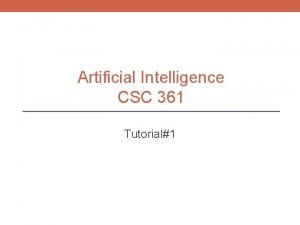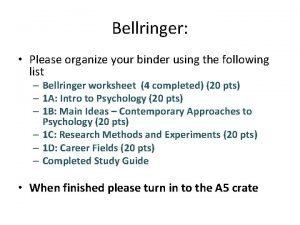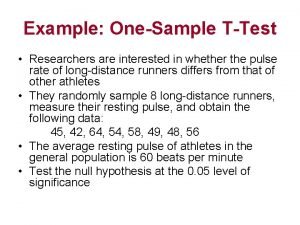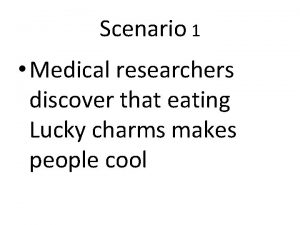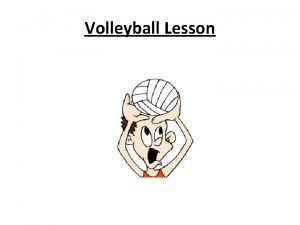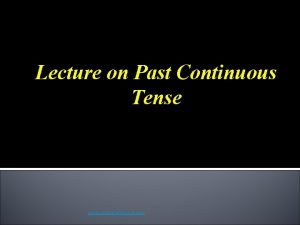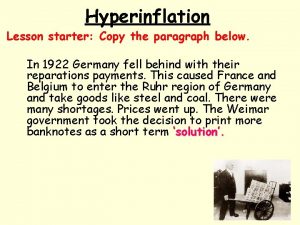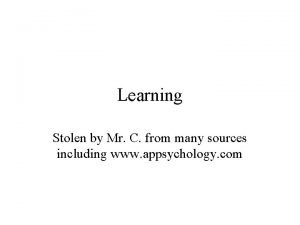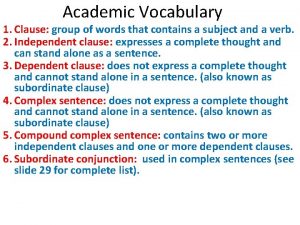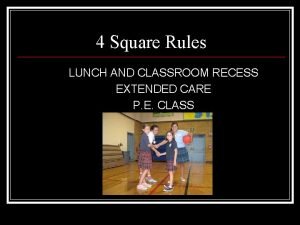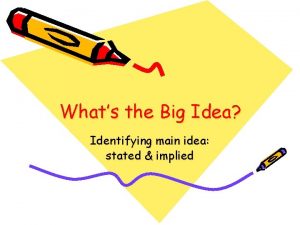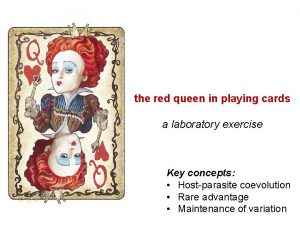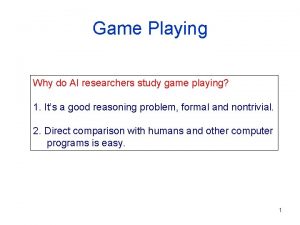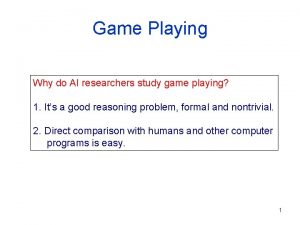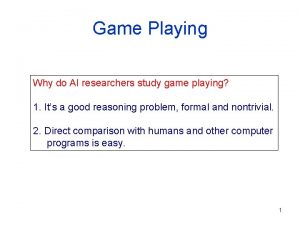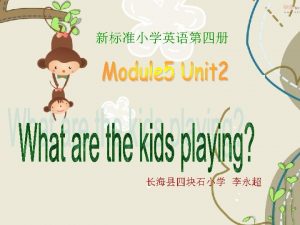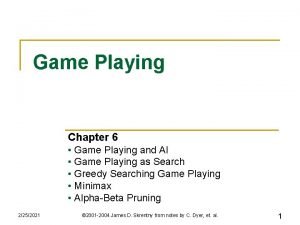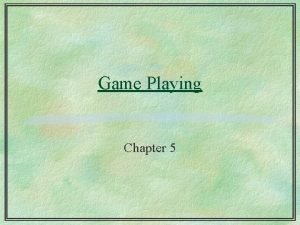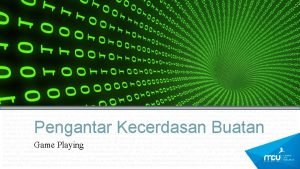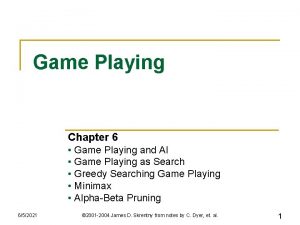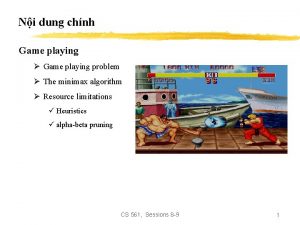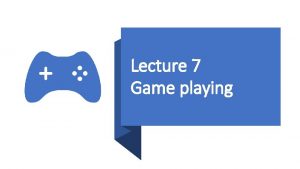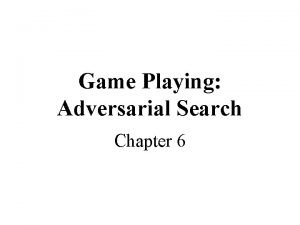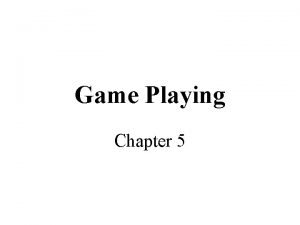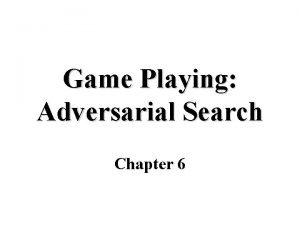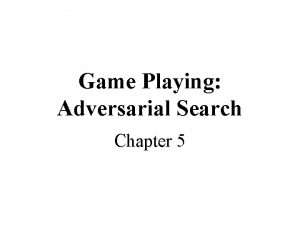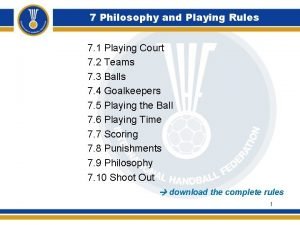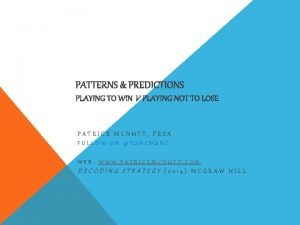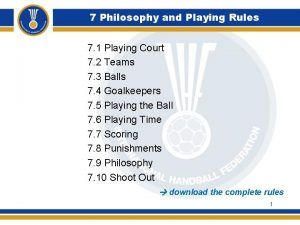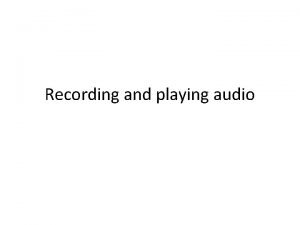Game Playing Why do AI researchers study game










































- Slides: 42

Game Playing Why do AI researchers study game playing? 1. It’s a good reasoning problem, formal and nontrivial. 2. Direct comparison with humans and other computer programs is easy. 1

What Kinds of Games? Mainly games of strategy with the following characteristics: 1. Sequence of moves to play 2. Rules that specify possible moves 3. Rules that specify a payment for each move 4. Objective is to maximize your payment 2

Games vs. Search Problems • Unpredictable opponent specifying a move for every possible opponent reply • Time limits unlikely to find goal, must approximate 3

Two-Player Game Opponent’s Move Generate New Position Game Over? yes no Generate Successors Evaluate Successors Move to Highest-Valued Successor no Game Over? yes 4

Game Tree (2 -player, Deterministic, Turns) computer’s turn opponent’s turn computer’s turn The computer is Max. The opponent is Min. opponent’s turn leaf nodes are evaluated At the leaf nodes, the utility function is employed. Big value 5 means good, small is bad.

Mini-Max Terminology • utility function: the function applied to leaf nodes • backed-up value – of a max-position: the value of its largest successor – of a min-position: the value of its smallest successor • minimax procedure: search down several levels; at the bottom level apply the utility function, back -up values all the way up to the root node, and that node selects the move. 6

Minimax • Perfect play for deterministic games • Idea: choose move to position with highest minimax value = best achievable payoff against best play • . , 2 -ply game: 7

Minimax Strategy • Why do we take the min value every other level of the tree? • These nodes represent the opponent’s choice of move. • The computer assumes that the human will choose that move that is of least value to the computer. 8

Minimax algorithm 9

Tic Tac Toe • Let p be a position in the game • Define the utility function f(p) by – f(p) = • largest positive number if p is a win for computer • smallest negative number if p is a win for opponent • RCDC – RCDO – where RCDC is number of rows, columns and diagonals in which computer could still win – and RCDO is number of rows, columns and diagonals in which opponent could still win. 10

Sample Evaluations • X = Computer; O = Opponent O O X X X O X X rows cols diags O X O rows cols diags 11

Minimax is done depth-first max min max leaf 2 5 1 12

Properties of Minimax • Complete? Yes (if tree is finite) • Optimal? Yes (against an optimal opponent) • Time complexity? O(bm) • Space complexity? O(bm) (depth-first exploration) • For chess, b ≈ 35, m ≈100 for "reasonable" games exact solution completely infeasible Need to speed it up. 13

Alpha-Beta Procedure • The alpha-beta procedure can speed up a depth-first minimax search. • Alpha: a lower bound on the value that a max node may ultimately be assigned v> • Beta: an upper bound on the value that a minimizing node may ultimately be assigned v< 14

α-β pruning example 15

α-β pruning example =3 alpha cutoff 16

α-β pruning example 17

α-β pruning example 18

α-β pruning example 19

Alpha Cutoff =3 >3 3 8 10 What happens here? Is there an alpha cutoff? 20

Beta Cutoff =4 <4 >8 4 8 cutoff 21

Alpha-Beta Pruning max min max eval 5 2 10 11 1 2 2 8 6 5 12 4 3 25 2 22

Properties of α-β • Pruning does not affect final result. This means that it gets the exact same result as does full minimax. • Good move ordering improves effectiveness of pruning • With "perfect ordering, " time complexity = O(bm/2) doubles depth of search • A simple example of the value of reasoning about which computations are relevant (a form of metareasoning) 23

The α-β algorithm cutoff 24

The α-β algorithm cutoff 25

When do we get alpha cutoffs? 100 < 100 . . . < 100 26

Shallow Search Techniques 1. limited search for a few levels 2. reorder the level-1 sucessors 3. proceed with - minimax search 27

Additional Refinements • Waiting for Quiescence: continue the search until no drastic change occurs from one level to the next. • Secondary Search: after choosing a move, search a few more levels beneath it to be sure it still looks good. • Book Moves: for some parts of the game (especially initial and end moves), keep a catalog of best moves to make. 28

Evaluation functions • For chess/checkers, typically linear weighted sum of features Eval(s) = w 1 f 1(s) + w 2 f 2(s) + … + wn fn(s) • e. g. , w 1 = 9 with f 1(s) = (number of white queens) – (number of black queens), etc. 29

Example: Samuel’s Checker. Playing Program • It uses a linear evaluation function f(n) = a 1 x 1(n) + a 2 x 2(n) +. . . + amxm(n) For example: f = 6 K + 4 M + U – K = King Advantage – M = Man Advantage – U = Undenied Mobility Advantage (number of moves that Max has that Min can’t jump after) 30

Samuel’s Checker Player • In learning mode – Computer acts as 2 players: A and B – A adjusts its coefficients after every move – B uses the static utility function – If A wins, its function is given to B 31

Samuel’s Checker Player • How does A change its function? 1. Coefficent replacement (node ) = backed-up value(node) – initial value(node) if > 0 then terms that contributed positively are given more weight and terms that contributed negatively get less weight if < 0 then terms that contributed negatively are given more weight and terms that contributed positively get less weight 32

Samuel’s Checker Player • How does A change its function? 2. Term Replacement 38 terms altogether 16 used in the utility function at any one time Terms that consistently correlate low with the function value are removed and added to the end of the term queue. They are replaced by terms from the front of the term queue. 33

Kalah P’s holes KP 6 6 6 Kp 0 0 counterclockwise 6 6 6 p’s holes To move, pick up all the stones in one of your holes, and put one stone in each hole, starting at the next one, including your Kalah and skipping the opponent’s Kalah. 34

Kalah • If the last stone lands in your Kalah, you get another turn. • If the last stone lands in your empty hole, take all the stones from your opponent’s hole directly across from it and put them in your Kalah. • If all of your holes become empty, the opponent keeps the rest of the stones. • The winner is the player who has the most stones in his Kalah at the end of the game. 35

Cutting off Search Minimax. Cutoff is identical to Minimax. Value except 1. Terminal? is replaced by Cutoff? 2. Utility is replaced by Eval Does it work in practice? bm = 106, b=35 m=4 4 -ply lookahead is a hopeless chess player! – – – 4 -ply ≈ human novice 8 -ply ≈ typical PC, human master 12 -ply ≈ Deep Blue, Kasparov 36

Deterministic Games in Practice 37

Games of Chance • What about games that involve chance, such as – rolling dice – picking a card • Use three kinds of nodes: – max nodes – min nodes – chance nodes min chance max 38

Games of Chance chance node with max children c di d 1 dk S(c, di) expectimax(c) = ∑P(di) max(backed-up-value(s)) i s in S(c, di) expectimin(c’) = ∑P(di) min(backed-up-value(s)) i s in S(c, di) 39

Example Tree with Chance max chance . 4 min chance . 6 . 4 . 6 . 4 1. 2 . 6 max leaf 3 5 1 4 1 2 4 5 40

Complexity • Instead of O(bm), it is O(bmnm) where n is the number of chance outcomes. • Since the complexity is higher (both time and space), we cannot search as deeply. • Pruning algorithms may be applied. 41

Summary • Games are fun to work on! • They illustrate several important points about AI. • Perfection is unattainable must approximate. • Game playing programs have shown the world what AI can do. 42
 Most dangerous game test
Most dangerous game test Hey bye bye
Hey bye bye Examine the ai literature to discover whether the following
Examine the ai literature to discover whether the following Complete as interrogações abaixo usando o past continuous
Complete as interrogações abaixo usando o past continuous Jillian and dawn are playing a game
Jillian and dawn are playing a game Greek vase shapes
Greek vase shapes Dont ask
Dont ask Researchers who are studying a new shampoo
Researchers who are studying a new shampoo What is the cardinal rule of naturalistic observation
What is the cardinal rule of naturalistic observation Newborn infants typically prefer
Newborn infants typically prefer Analogue studies are used when researchers ____.
Analogue studies are used when researchers ____. Researchers
Researchers Difference between independent and one sample t test
Difference between independent and one sample t test Medical researchers discover that eating lucky charms
Medical researchers discover that eating lucky charms Medical researchers discover that eating lucky charms
Medical researchers discover that eating lucky charms Medical researchers followed 6272 swedish
Medical researchers followed 6272 swedish Volleyball playground diagram
Volleyball playground diagram I like play badminton
I like play badminton Achilles and ajax playing dice
Achilles and ajax playing dice Analytic rubric for role playing
Analytic rubric for role playing I enjoy playing basketball revision
I enjoy playing basketball revision Yesterday evening reported speech
Yesterday evening reported speech Role-playing dimensions power bi
Role-playing dimensions power bi Playing nice in the sandbox
Playing nice in the sandbox Checkmate picture devil
Checkmate picture devil Process-oriented learning competencies in role playing
Process-oriented learning competencies in role playing I meet john in town yesterday
I meet john in town yesterday German kids playing with money
German kids playing with money Barry liked playing board games
Barry liked playing board games Playing god (ethics)
Playing god (ethics) Even playing field meaning
Even playing field meaning My hobby is keeping fish. i have a modest
My hobby is keeping fish. i have a modest Variable interval
Variable interval Theme and topic difference
Theme and topic difference Older television sets had tubes
Older television sets had tubes Four square snake eyes
Four square snake eyes Two types of main idea
Two types of main idea She likes playing table tennis.
She likes playing table tennis. Four materials used by the tainos to construct their homes
Four materials used by the tainos to construct their homes Red queen in deck of cards
Red queen in deck of cards Sintaks role playing
Sintaks role playing Dbm9 guitar chord
Dbm9 guitar chord Yesterday we play
Yesterday we play


